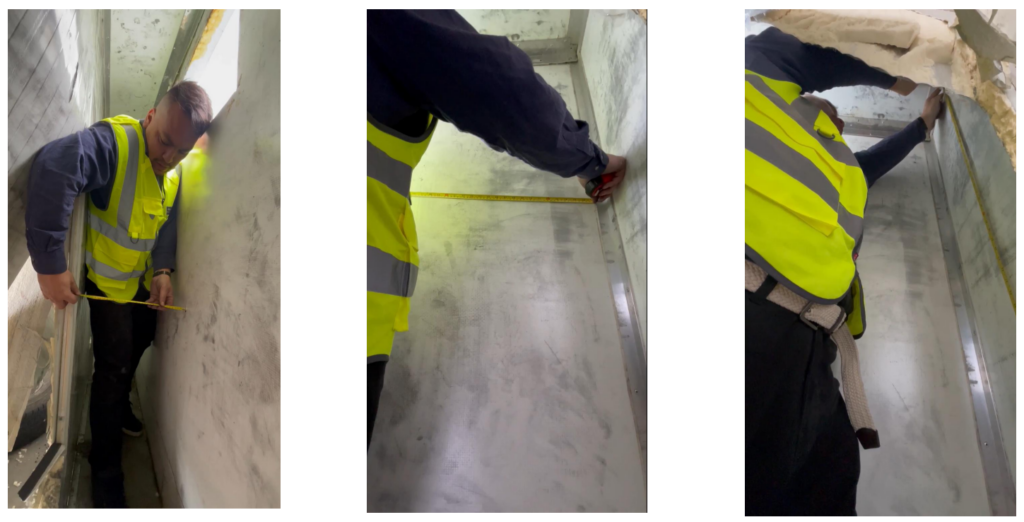A driver smuggled seven Vietnamese people aboard a ferry to Newhaven crammed into a tiny hidden section of a van, a court was told.
The sealed unit was less than two metres high, and two metres by 37cm wide, leaving them “starved of oxygen” during the crossing from Dieppe to Newhaven.
When a crew member heard banging and desperate cried for help, he alerted the captain of the Seven Sisters ferry.
The driver of the Ford Iveco van, Anas Al Mustafa, 43, did not respond to a ship’s tannoy and crew members had to use an axe to rescue the trapped migrants.
Two were unconscious and they were all taken to hospital, a jury was told at Lewes Crown Court today (Tuesday 20 August).
Nick Corsellis, prosecuting, said: “The captain was notified by a crew member who happened to be patrolling in the garage among the lorries and cars that crew member had heard banging and screaming coming from a refrigerated van parked on deck there.
“The crew reacted with admirable speed and climbed on to the cab where they discovered that what purported to be a refrigerated unit was in fact a dummy unit – hollowed out – and it hid the entrance to a compartment that was very thin but housed seven human beings.
“The reason the migrants were calling for help was because they were being starved of oxygen and suffering from dehydration.
“When they were rescued, a number of them were in such a state that they needed emergency medical attention.
“When the ship’s captain attended the van, he organised for a call to be made over the ship’s tannoy for the driver to make himself known to the crew.
“There was no response. The captain ordered that the passenger manifest be obtained to show who and where the driver was in the ship.
“The driver’s cabin was located and it was Mr Al Mustafa’s.
“In the meantime, the captain and crew took emergency steps to assist those concealed.
“The rear doors to the van were, surprisingly, unlocked and there was nothing in the rear of the van.
“But, clearly from the noise, there was a false partition that housed people. There was no obvious point of access from inside the compartment. The crew checked underneath to see if there was a trap door but there wasn’t.
“Bearing in mind the obvious emergency from the distress of the migrants, that the driver had not responded to emergency calls, there being no door or means of escape, the crew of the ferry resorted to using an axe to break down the partition at the end of the refrigeration unit and they were able to free the seven people inside.
“To give you an idea of scale of the hide, it was a sealed unit that measured two metres wide and was 194cm in height. But it was just 37cm narrow in width.
“This was, no doubt, an effort to make the unit to be undetectable as possible to the naked eye of an immigration officer when one looked at the outside of the van and then the inside.
“To see that it was 37cm shorter was negligible. Realistically no one would see that it was any different. It was about the width of a human chest.

“But the width of it meant that the human beings were forced to stand and could not move to any meaningful degree. There was no water provided for them.
“The heat created by seven people in such a small space and the lack of sufficient oxygen had created a highly dangerous situation.
“The heat had forced some of the migrants to remove their clothes and, by the time they were rescued, two of the migrants had succumbed to the heat conditions and lack of air to the extent that they had lost consciousness.
“It was no doubt this mortal emergency that forced them to call for help in desperation.
“At about 8am, one of them had used their mobile telephone to try to call 112 – an emergency number.
“While, for whatever reason, the defendant did not hear or respond to the call for his attendance, other passengers did.
“Sari Gehle was an Australian nurse visiting friends and family in Europe with her young children.
“She heard several announcements over the ship’s tannoy which were difficult to understand until she heard a request for a doctor or a nurse to assist the ship’s crew.
“She left her children to make herself available and was taken to the location of the van on the deck.
“Once there, she saw seven people lying on the floor in various stages of undress and consciousness.
“It was a confusing situation because of the language barriers – a French crew, she only spoke English and the only migrant capable of speaking spoke Vietnamese.
“Despite this, she was able to assist with the provision of oxygen and emergency medical supervision using the facilities on the boat.
“Ms Gehle noticed one person stood out in contrast to the situation. He was an Asian male with a puffa jacket and was sitting on the ground seemingly scrolling through his telephone and was, in her view, remarkably calm. That was the defendant.
“Lucy Bristo was another member of the public who answered the call for assistance over the ship’s tannoy. She had experience in providing emergency care from her previous employment and assisted in the recovery operation.
“The severity of the migrants’ plight was reflected by their condition. They were taken to hospital and treated. Expert medical care was provided to them.”
Al Mustafa, a Syrian man who came to Britain in 2011, of Heather Crescent, Swansea, denies trying to smuggle or traffic illegal migrants into the country.
The trial continues.








